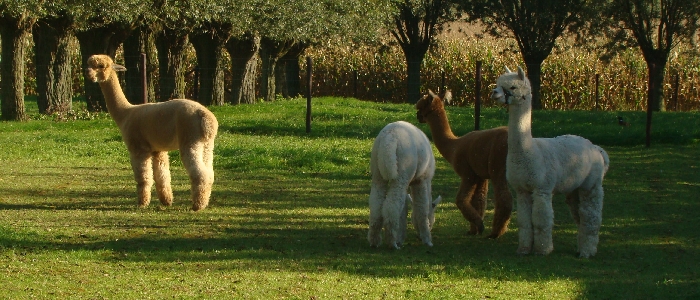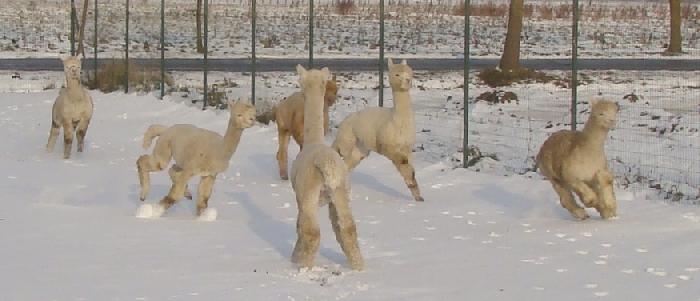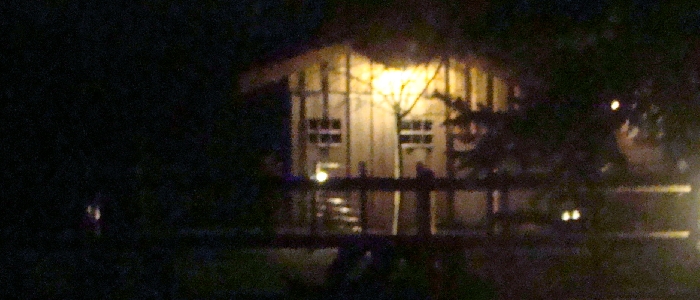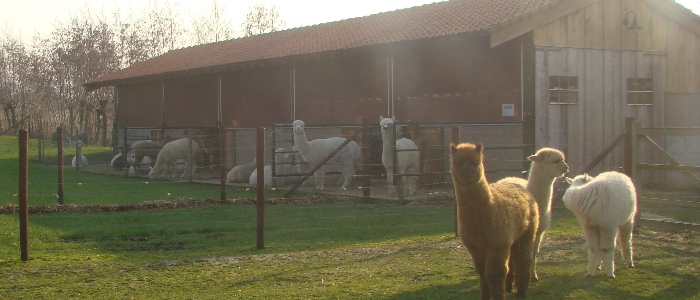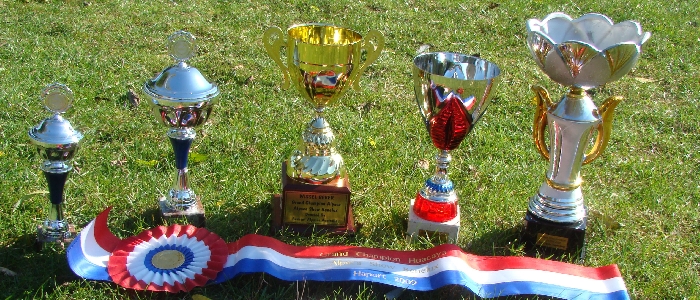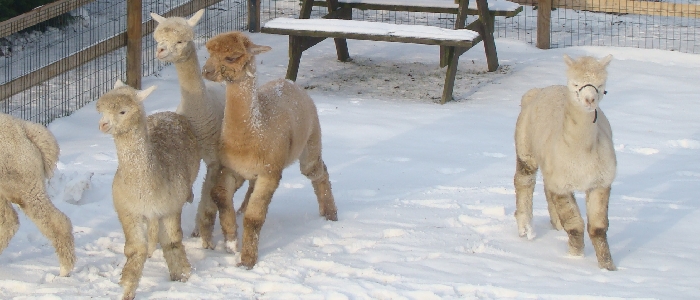Verbetering van de kudde door keuze van de hengst
Herd Improvement through Choice of Studs
By Nic Cooper, Southern Alpacas Stud
As the choice grows in NZ for studs, the buyer needs to become more discerning.
The key for breeders, whether buying a male or buying stud services, is to match the specific attributes of the stud being considered, to the gaps in your breeding programme, and hope that the stud in question will pass on those attributes into your herd.
There is no overall "better/best" in all of this - no overall brilliant stud, way ahead of the rest. Different studs offer different strengths. Go and see the stud(s) on offer, enquire about genetic background, get hands on the progeny, see the documents for shear weights and microns, ask for AGE data, and match the information you gain to your specific herd improvement need.
BREEDING GOALS:
What is your breeding goal? If you have not got one - get one. It may be breeding fine fibred whites for the commercial fleece market. Or attractive dark brown alpacas with white faces and socks, and a nice temperament for pets.
Alpaca breeders should breed "up", to add quality and/or vigour and diversity to the herd. Now that we have AGE, the Across-herd Genetic Evaluation, what is being bred for, can be measured.
The use of "venerable ancestors" has had a huge positive influence on the herd in Australasia and USA, and now, after 12 years, their improved sons and grandsons are available as studs. The improved but lesser know son should be a better value buy than the lauded venerable ancestor or unproven, unknown import.
For fibre breeding goals please remember that different fibre characteristics suit different markets and products. What crimp style do you want to breed? Are you after density or fineness? SD and CV considerations? Your fibre breeding goals must synchronise with your product intentions for them to succeed.
Whatever your breeding goal is, to maximise your return from the stud fee or male purchase, you need to ensure the male is best suited for your female and your breeding plan.
Selection considerations:
AGE: Ask for the AGE data - Across-herd Genetic Evaluation - generated for the male. The AGE project, whilst in its infancy, is the first real targeted, mathematical, unbiased key performance indicator system for alpacas. Use it! Match the factors you consider important in your breeding goal with the AGE ranking of various studs you are considering.
Pedigree: Check the registry for the pedigree of the stud and your female for common ancestors, especially with Australasia’s small genetic base. Line breeding is, in my opinion, an absolute no-no in these animals at this stage of genetic knowledge.
Colour: Always expect a few exceptions here, but (for example) if you are breeding for whites it is best to breed to a white that is homozygous white, not heterozygous, especially if some of your females display brown spots or fawn glazing. Breeding for black is genetically the easiest. Breeding for greys, the hardest. (see our article on this)
Conformation. All alpacas should have perfect conformation. But if your female has, for example, slightly sickle hocks do not mate her to a male with a similar trait. If you have a preference for nose shapes, select that way, similarly with body size.
Presence and temperament are at least in part genetic. If these things are important for you, select for them in your purchase and stud decisions.
Fibre traits are many, and very few stud males are strong in all aspects. Micron and shearweight are generally seen to be the most important in huacaya, lustre in suri.
But micron and shearweight are contra-indicative - lower micron and higher shearweight do not easily go hand-in-hand.
Remember Don Julio Barreda’s long given advice to fix density in your herd before attempting to improve fineness.
Also consider lustre and fleece character (crimp or style).
Crimp style is becoming a more important breeding selection criteria.
The importance of crimp is still debated. But recent research (Yocum-McColl and Cameron Holt) is making things a lot clearer.
In alpaca there is a close correlation between fineness, curvature and crimps per inch (cpi). Higher curvature figures correlate positively to a higher number of crimps per inch, and negatively with fibre diameter (i.e. high curve, and high cpi mean finer fibre.)
Consider uniformity (the percentage of the total fleece that is usable in top grade production). Uniformity changes considerably with age.
Also consider uniformity across your herd. When mixing fleece to make a product, the constituent fleeces should be similar (uniform). Look at your herd statistics, not just individual alpacas, and see how you can select and use studs to minimise your within herd divergence.
YOUR STUD DECISION
This is your business, and apart from your initial female purchase decision, the stud fee/male purchase is about the most critical long term success decision you will make. Make sure it is a fully informed decision that best meets your breeding plan, not one driven by hype, trend, show results or stud marketing. Check through in your own mind what you are hearing to ensure that it makes sense, and is supported by the facts.
Remember the alpaca industry is maturing and changing quickly. For the last decade we have relied on "venerable ancestors" to breed to our females. If we are truly progressing we need to be using the (best) offspring of these forefathers. In a successful breeding programme, the son will supplant his sire in 3 - 4 years.
BUY IN OR CONTRACT IN ?
Whether to buy a stud or contract in stud services is a decision all breeders get to eventually as their female numbers mount and consequently stud fees add up.
The move from stud services to stud ownership should be phased in, with three steps, as the herd grows.
1. Buying in stud services
2. Buying in stud services, negotiating for discounted fees or free matings as part of a package purchase
3. Purchasing a stud, or a share in a stud.
If purchasing, the outlay for a "top" stud can be in excess of what smaller breeders can find economic, with well over $50,000 being not unusual for an imported proven top genetic stud male. I have seen a number of smaller breeders paying $10,000 - $15,000 for unproven males with very little genetic strength, and being disappointed with the resulting progeny.
Less expensive than buying, is breeding your own. To do this you have to own a very high quality female, buy in top stud services for her, and hope for the birth of a male at the top end of the potential genetic spectrum of both parents. Genetic statistics indicate that occurrence of such an event is rare.
There are pro’s and con’s to the buy/contract decision:
BUYING:
You save stud fees, but it is expensive to get a good proven quality stud
Tendency to go for cheaper unproven males, giving fertility, pre-potency and progeny risk, and management problems in the bring-in phase
Physical management of a stud on the farm can be a hassle, especially if the male is not getting constant work
Getting a young male "settling" his first female (getting her pregnant) can at times be difficult
Need to get into "a whole new business line" offering stud services to offset the cost of the purchase (requiring capital costs of stud transport, time, and stud master knowledge)
Still need outside stud fees for your stud’s offspring and for your best female(s) to improve your herd
Re-sale values of stud males tend to plummet with age
In all but the exceptional circumstance the reward of owning your own stud is not great. In USA I asked the owner of the male winning its colour age class in AOBA, and the Reserve Colour Champion, how many outside matings (at US$3,000) he, as a small breeder, had achieved. The answer was 4 this year, 3 last year.
CONTRACTING:
*Proven stud arrives for a fortnightly visit - or your girl goes to him
*Stud management, bring-on risk and additional business hassle left to the professional
*There is an ability to switch stud should the progeny from the combination of genetics not be what you expected
*Using different stud males ensures wide genetics and avoids line breeding within your herd
*Regular payments are required for stud service fees - although overall "value" should be given through the offspring and return service guarantees
I know one breeder who "finances" the year’s stud fees through the sale of one female, but the fees of course produce several females each year to replace her.
We are finding that purchasing "part" of a higher quality stud male gives smaller breeders the ability to achieve a higher genetic level, for a lower price long term, and with more flexibility, than the full own stud ownership option.
CASE STUDY:
Here is an example from a consultancy I am undertaking for a small breeder in the North East USA:
They have several females (white with a tendency to brown spots), a white stud male with an excellent named sire behind him but nondescript dam, and a brown stud male that originated from NZ Chilean stock (!), but who had just won a second in his class at the Nationals. They were disappointed in their female offspring’s results at the Nationals, and asked advice on how to improve them.
They had a breeding plan - to breed high quality white huacayas. But they had no shearweights, no microns, and were intending to put the daughters of their white stud to their brown male. My first advice was - don’t!
My second advice was to find out where their herd stood - what attributes were strong, and what needed improvement.
A "hands on", knowing the sire, confirmed the expected - females with good conformation, fine, and lustrous, but little density, and the character of fleece was inconsistent down the staple and around the body. The animals carried no presence.
We needed more solid data and this was easy to obtain as we were at the largest alpaca show on earth at the AOBA (Alpaca Owners and Breeders Association) Conference. Down to the shearers - shear, segregate, grade, weigh the fleece. Indeed density/shearweight was a concern, as was the low percentage of fleece that was first grade.
Then to the micron tester with samples. In the USA microns are rarely tested, due, I think due to a fallacy put around by bigger breeders that micron testing can be abused and hence is not credible. (It certainly saves the breeders having to defend comparisons!) All three females tested 19 micron, with a 23% cv.
So with the solid data confirming first thoughts, where next? Whilst it was clear to me that outside stud services were required, the client had to come to terms with US$3,000+ stud fees, and their females being off farm whilst it all happened. Fortunately the clients were happy with the suggestion, so we could proceed.
So off down stud row. We wanted to be sure of holding the female’s better qualities whilst standing a great chance of improving the weaker ones. We wanted a stud that at least equalled the females in micron and lustre, displayed a lower cv, displayed quality fibre into lower legs, belly and brisket, sheared at least 12 lbs (5 kg), and had great presence. And we were looking for proof that the stud did pass these attributes on to its progeny. Without saying, we wanted one or two of the venerable ancestor lines of the US herd in the background. And if possible we wanted a stud located in the North East, or close, as transport to (say) Oregon is an expensive task.
On stud row, we saw a number of males, and although the top studs were not present at the show, we were able to talk to their owners. It absolutely amazed me that few knew the microns, shearweights, or progeny information of their studs (or were willing to divulge them!). They showed great photos and talked of their show results, but had little solid measurable data, especially on the more esoteric areas of character and lustre.
One farm is an exception - it keeps all of the fleeces from all of their studs from each year’s successive shearing, to show clients. They have over 500 fleeces displayed.
So now the client has a shortlist of stud males that could do the job. As he is going to spend over US$12,000 on stud fees and transport, he believes it is worth spending a few hundred dollars visiting the farms, viewing the studs, seeing their fleece and progeny. We will select one (or maybe two) and move his females to the stud for mating. Hopefully (the vagaries of genetic improvement notwithstanding), the progeny will be improved in the areas desired.
He does recognise, however that it can not all be done in one generation, and the same evaluation and selection process will need to take place on the offspring to move them forward. At that time there may be different attributes emphasised for improvement, and hence a different stud selection.
Definitions
"Stud" - a male alpaca that has impregnated a female and usually offered for outside stud services.
"Herdsire" - a US term similar to stud, but more for an alpaca based in the home herd, and not offered for extensive outside stud matings.
"Proven stud" - a male with viable offspring on the ground.
[2009-02-23 door Nic Cooper]

